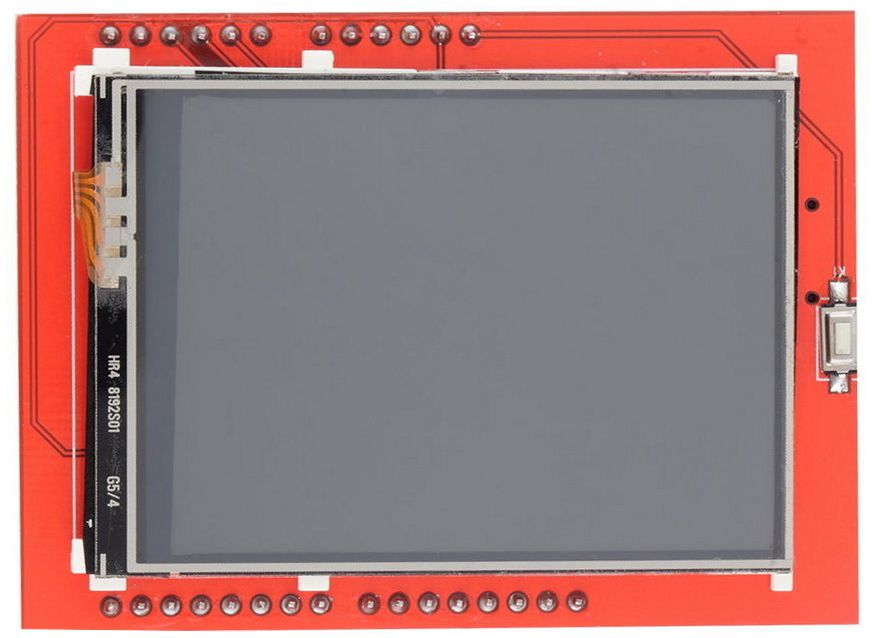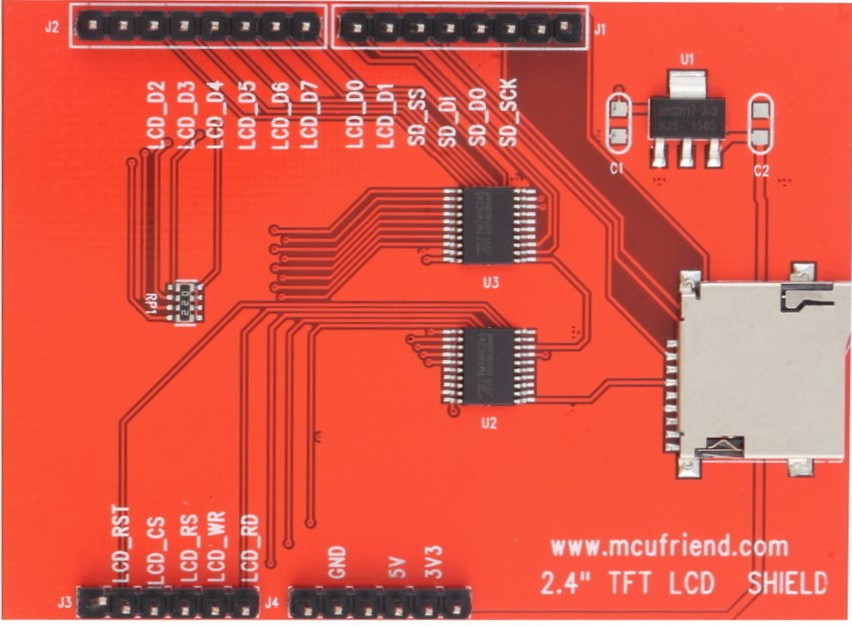mcufriend 2.4 TFT LCD Shield Lib
Dependents: Nucleo_LCD_mcufriend_test
Fork of 24_TFT_STMNUCLEO by
mcufriend 2.4" TFT LCD Shield


Import program
00001 #include "mbed.h" 00002 #include "ili9328.h" 00003 00004 // prepare the data bus for writing commands and pixel data 00005 BusOut dataBus( D8, D9, D2, D3, D4, D5, D6, D7 ); // 8 pins 00006 // create the lcd instance 00007 ILI9328_LCD lcd( A3, A4, A2,A1, &dataBus, NC, A0); // control pins and data bus 00008 //ILI9328_LCD( CS, RESET, RS, WR, BusOut* DATA_PORT, PinName BL = NC, RD ); 00009 00010 int main() 00011 { 00012 int ii,height,width; 00013 00014 height = lcd.GetHeight(); 00015 width = lcd.GetWidth(); 00016 // initialize display - place it in standard portrait mode and set background to black and 00017 // foreground to white color. 00018 lcd.Initialize(); 00019 00020 // print something on the screen 00021 lcd.Print( "Hello, World!", CENTER, 50); // align text to center horizontally and use starndard colors 00022 00023 wait(2); 00024 00025 lcd.ClearScreen(); 00026 00027 for(ii=0;ii<width;ii++) 00028 { 00029 lcd.DrawLine(0, 0, height, ii,COLOR_GREEN); 00030 ii = ii+10; 00031 } 00032 wait(2); 00033 00034 lcd.DrawCircle(height/4, width/4, 20, COLOR_GREEN); 00035 wait(2); 00036 00037 lcd.FillCircle(height/2, width/2, 50, COLOR_GREEN); 00038 wait(2); 00039 00040 lcd.FillTriangle(height/4, width/4,(height/4)+20, (width/4)+40,(height/4)-20, (width/4)+40, COLOR_RED); 00041 00042 while ( 1 ) { } 00043 }
HW information about the mcufriend LCD Shield
Diff: ili9328.h
- Revision:
- 24:ac6e35658037
- Parent:
- 23:eca4414196ca
--- a/ili9328.h Thu Jun 13 03:47:51 2013 +0000
+++ b/ili9328.h Sat Jun 15 05:34:53 2013 +0000
@@ -35,18 +35,143 @@
extern "C" {
#endif
+/** Represents a LCD instance.
+ *
+ * This is the utility class, through which the display can be manipulated
+ * and graphics objects can be shown to the user. A known display, which
+ * works with this library is the INANBO-T24-ILI9328-V11 - a RGB TFT
+ * with 240x320 pixels resolution and 65K/262K colors, using 8/16-bit interface.
+ *
+ * The display works with a supply voltage of 2.8-3.3 volts for both logic and
+ * backlight. It can be driven in 8bit or 16bit interface mode. (Current
+ * version of the driver works only in 16bit mode for now.)
+ *
+ * How to use:
+ * \code
+ * // include the library, this will also pull in the header for the provided fonts
+ * #include "ili9328.h"
+ *
+ * // prepare the data bus for writing commands and pixel data
+ * BusOut dataBus( p30, p29, p28, p27, p26, p25, p24, p23, p22, p21, p20, p19, p18, p17, p16, p15 ); // 16 pins
+ * // create the lcd instance
+ * ILI9328_LCD lcd( p14, p13, p12, p11, &dataBus ); // control pins and data bus
+ *
+ * int main()
+ * {
+ * // initialize display - place it in standard portrait mode and set background to black and
+ * // foreground to white color.
+ * lcd.Initialize();
+ * // set current font to the smallest 8x12 pixels font.
+ * lcd.SetFont( Font8x12 );
+ * // print something on the screen
+ * lcd.Print( "Hello, World!", CENTER, 25 ); // align text to center horizontally and use starndard colors
+ *
+ * while ( 1 ) { }
+ * }
+ *
+ * \endcode
+ * \version 0.1
+ * \author Todor Todorov
+ */
class ILI9328_LCD : public LCD
{
public:
+ /** Creates a new instance of the class.
+ *
+ * \param CS Pin for the ChipSelect signal.
+ * \param RESET Pin for the RESET line.
+ * \param RS Pin for the RS signal.
+ * \param WR Pin for the WR signal.
+ * \param DATA_PORT Address of the data bus for transfer of commands and pixel data.
+ * \param BL Pin for controlling the backlight. By default not used.
+ * \param RD Pin for the RD signal. This line is not needed by the driver, so if you would like to
+ * use the pin on the mbed for something else, just pull-up the respective pin on the LCD high,
+ * and do not assign a value to this parameter when creating the controller instance.
+ * \param blType The backlight type, the default is to utilize the pin - if supplied - as a simple on/off switch
+ * \param defaultBacklightLevel If using PWM to control backlight, this would be the default brightness in percent after LCD initialization.
+ */
ILI9328_LCD( PinName CS, PinName RESET, PinName RS, PinName WR, BusOut* DATA_PORT, PinName BL = NC, PinName RD = NC, backlight_t blType = Constant, float defaultBackLightLevel = 1.0 );
+
+ /** Initialize display.
+ *
+ * Wakes up the display from sleep, initializes power parameters.
+ * This function must be called first, befor any painting on the
+ * display is done, otherwise the positioning of graphical elements
+ * will not work properly and any paynt operation will not be visible
+ * or produce garbage.
+ *
+ * \param oritentation The display orientation, landscape is default.
+ * \param colors The correct color depth to use for the pixel data. Value is disregarded.
+ */
virtual void Initialize( orientation_t orientation = LANDSCAPE, colordepth_t colors = RGB16 );
+
+ /** Puts the display to sleep.
+ *
+ * When the display is in sleep mode, its power consumption is
+ * minimized. Before new pixel data can be written to the display
+ * memory, the controller needs to be brought out of sleep mode.
+ * \sa #WakeUp( void );
+ * \remarks The result of this operation might not be exactly as
+ * expected. Putting the display to sleep will cause the
+ * controller to switch to the standard color of the LCD,
+ * so depending on whether the display is normally white,
+ * or normally dark, the screen might or might not go
+ * dark. Additional power saving can be achieved, if
+ * the backlight of the used display is not hardwired on
+ * the PCB and can be controlled via the BL pin.
+ */
virtual void Sleep( void );
+
+ /** Wakes up the display from sleep mode.
+ *
+ * This function needs to be called before any other, when the
+ * display has been put into sleep mode by a previois call to
+ * #Sleep( void ).
+ */
virtual void WakeUp( void );
protected:
+ /** Sends a command to the display.
+ *
+ * \param cmd The display command.
+ * \remarks Commands are controller-specific and this function needs to
+ * be implemented separately for each available controller.
+ */
virtual void WriteCmd( unsigned short cmd );
+
+ /** Sends pixel data to the display.
+ *
+ * \param data The display data.
+ * \remarks Sending data is controller-specific and this function needs to
+ * be implemented separately for each available controller.
+ */
virtual void WriteData( unsigned short data );
+
+ /** Assigns a chunk of the display memory to receive data.
+ *
+ * When data is sent to the display after this function completes, the opertion will
+ * start from the begining of the assigned address (pixel position) and the pointer
+ * will be automatically incremented so that the next data write operation will continue
+ * with the next pixel from the memory block. If more data is written than available
+ * pixels, at the end of the block the pointer will jump back to its beginning and
+ * commence again, until the next address change command is sent to the display.
+ *
+ * \param x1 The X coordinate of the pixel at the beginning of the block.
+ * \param y1 The Y coordinate of the pixel at the beginning of the block.
+ * \param x2 The X coordinate of the pixel at the end of the block.
+ * \param y2 The Y coordinate of the pixel at the end of the block.
+ * \remarks Addressing commands are controller-specific and this function needs to be
+ * implemented separately for each available controller.
+ */
virtual void SetXY( unsigned short x1, unsigned short y1, unsigned short x2, unsigned short y2 );
+
+ /** Sets the color of the pixel at the address pointer of the controller.
+ *
+ * This function is to be provided by each implementation separately in
+ * order to account for different color depth used by the controller.
+ * \param color The color of the pixel.
+ * \param mode The depth (palette) of the color.
+ */
virtual void SetPixelColor( unsigned int color, colordepth_t mode = RGB24 );
private:
